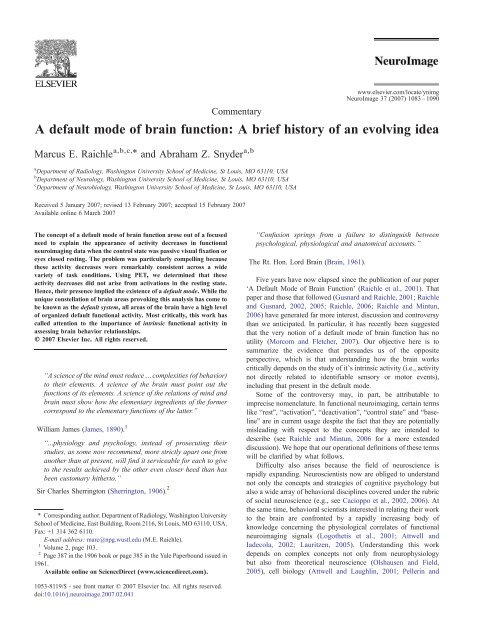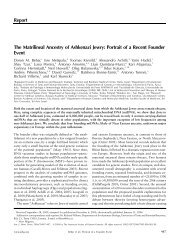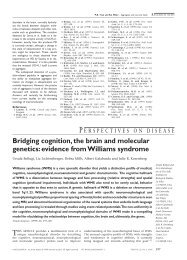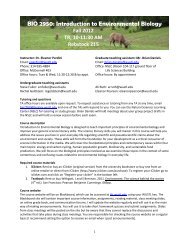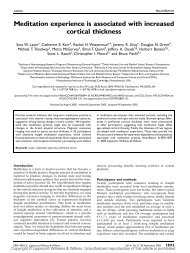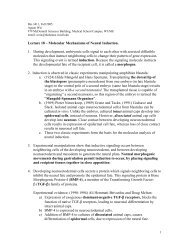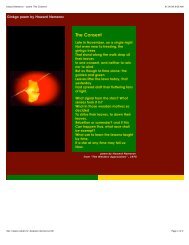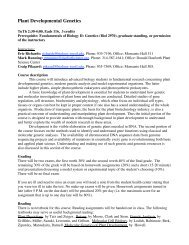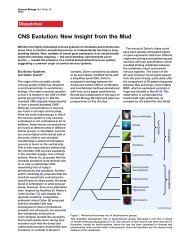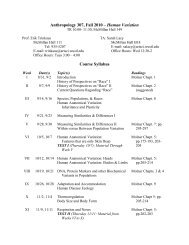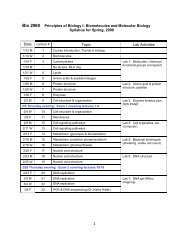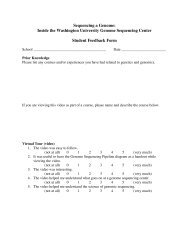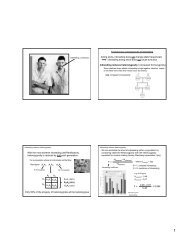A default mode of brain function: A brief history of an evolving idea
A default mode of brain function: A brief history of an evolving idea
A default mode of brain function: A brief history of an evolving idea
You also want an ePaper? Increase the reach of your titles
YUMPU automatically turns print PDFs into web optimized ePapers that Google loves.
M.E. Raichle, A.Z. Snyder / NeuroImage 37 (2007) 1083–10901085visual field, whereas the task state <strong>of</strong> interest requires a decisionabout the color <strong>of</strong> the light prior to the key press. Assuming pureinsertion, the response latency difference between conditions isinterpretable as the time needed to perform a color discrimination.However, the time needed to press a key might be affected by thenature <strong>of</strong> the decision process itself, violating the assumption <strong>of</strong>pure insertion. More generally, the <strong>brain</strong> state underlying <strong>an</strong>yaction could have been altered by the introduction <strong>of</strong> <strong>an</strong> additionalprocess. Interestingly, <strong>function</strong>al neuroimaging helped address thequestion <strong>of</strong> pure insertion by employing the device <strong>of</strong> reversesubtraction. Thus, in certain circumst<strong>an</strong>ces subtracting task statedata from control state data revealed negative responses, or taskspecificdeactivations (for examples <strong>an</strong>d further discussion <strong>of</strong> thisinteresting issue see Raichle et al., 1994; Petersen et al., 1998;Raichle, 1998). It was clearly shown, just as psychologists hadsuspected, that processes active in a control state could be modifiedwhen paired with a particular task. However, none <strong>of</strong> this workprepared us for nor <strong>an</strong>ticipated “the problem”.‘The problem,’ as we now think <strong>of</strong> it, arose unexpectedly whenwe noted, quite by accident, that activity decreases were present inour subtraction images even when the control state was either visualfixation or eyes closed rest. What particularly caught our attentionwas the fact that, regardless <strong>of</strong> the task under investigation, theactivity decreases almost always included the posterior cingulate<strong>an</strong>d adjacent precuneus, a region we nicknamed MMPA for ‘medialmystery parietal area’.The first formal characterization <strong>of</strong> task-induced activitydecreases (Shulm<strong>an</strong> et al., 1997) generated a set <strong>of</strong> iconic images(Fig. 1A) whose unique identity was amply confirmed in later meta<strong>an</strong>alysesby Jeffery Binder <strong>an</strong>d colleagues at the Medical College <strong>of</strong>Wisconsin (Binder et al., 1999) <strong>an</strong>d Bernard Mazoyer <strong>an</strong>d hiscolleagues (Mazoyer et al., 2001) in Fr<strong>an</strong>ce. Similar observations arenow <strong>an</strong> everyday occurrence in laboratories throughout the worldleaving little doubt that a specific set <strong>of</strong> <strong>brain</strong> areas decrease theiractivity across a remarkably wide array <strong>of</strong> task conditions whencompared to a passive control condition such as visual fixation.The finding <strong>of</strong> a network <strong>of</strong> <strong>brain</strong> areas frequently seen todecrease its activity during goal directed tasks (Fig. 1A) was bothsurprising <strong>an</strong>d challenging. Surprising because the areas involvedhad not previously been recognized as a system in the same waywe might think <strong>of</strong> the motor or visual system. And, challengingbecause initially it was unclear how to characterize their activity ina passive or resting condition.For us the issue <strong>of</strong> characterizing activity decreases came to ahead in 1998 when a paper we were attempting to publish wasrejected because <strong>of</strong> the way in which we characterized activityFig. 1. Perform<strong>an</strong>ce <strong>of</strong> a wide variety <strong>of</strong> tasks has called attention to a group <strong>of</strong> <strong>brain</strong> areas (A) that decrease their activity during task perform<strong>an</strong>ce (data adaptedfrom Shulm<strong>an</strong> et al., 1997). If one records the spont<strong>an</strong>eous fMRI BOLD signal activity in these areas in the resting state (arrows, A) what emerges is a remarkablesimilarity in the behavior <strong>of</strong> the signals between areas (B). Using these fluctuations to <strong>an</strong>alyze the network as a whole (Fox et al., 2005; Vincent et al., 2006)reveals a level <strong>of</strong> <strong>function</strong>al org<strong>an</strong>ization (C) that parallels that seen in the task related activity decreases. These data provide a dramatic demonstration that theongoing org<strong>an</strong>ization <strong>of</strong> the hum<strong>an</strong> <strong>brain</strong> likely provides a critical context for all hum<strong>an</strong> behaviors. These data were adapted from our earlier published work(Shulm<strong>an</strong> et al., 1997; Gusnard <strong>an</strong>d Raichle, 2001; Raichle et al., 2001; Fox et al., 2005).
1086 M.E. Raichle, A.Z. Snyder / NeuroImage 37 (2007) 1083–1090ch<strong>an</strong>ges <strong>of</strong> the type seen in Fig. 1A. 6 One <strong>of</strong> the referees wrote, “Thisis the most controversial aspect <strong>of</strong> this paper as it (1) c<strong>an</strong>not be ruledout that these signal ch<strong>an</strong>ges are actual activations in the so-calledresting state <strong>an</strong>d (2) the physiological mech<strong>an</strong>isms underpinning agenuine BOLD signal decrease remain a matter <strong>of</strong> speculation”. 7It was clear that we needed a way to determine whether or nottask-induced activity decreases were simply ‘activations’ present inthe absence <strong>of</strong> <strong>an</strong> externally-directed task <strong>an</strong>d <strong>an</strong> expl<strong>an</strong>ationregarding why they should appear in both PET <strong>an</strong>d fMRI<strong>function</strong>al neuroimaging studies. In wrestling with these difficultissues two things came to mind that, together, we felt <strong>of</strong>fered us <strong>an</strong>opportunity to move forward. 8First, the m<strong>an</strong>ner in which <strong>function</strong>al neuroimaging wasconducted with fMRI carried with it a physiological definition <strong>of</strong>activation that could be measured with PET. This definition arosefrom qu<strong>an</strong>titative circulatory <strong>an</strong>d metabolic PET studies demonstratingthat when <strong>brain</strong> activity increases tr<strong>an</strong>siently above aresting state, blood flow increases more th<strong>an</strong> oxygen consumption(Fox <strong>an</strong>d Raichle, 1986; Fox et al., 1988). As a result, the amount<strong>of</strong> oxygen in blood increases locally as the ratio <strong>of</strong> oxygenconsumed to oxygen delivered falls. This ratio is known as theoxygen extraction fraction or the OEF. Activation c<strong>an</strong> then bedefined physiologically as a tr<strong>an</strong>sient local decrease in the oxygenextraction or, if you like, a tr<strong>an</strong>sient increase in oxygen availability.The practical consequence <strong>of</strong> this observation was to lay thephysiological groundwork for <strong>function</strong>al MRI using blood oxygenlevel dependent or BOLD contrast, (Thus, MRI is sensitive to thelevel <strong>of</strong> blood oxygenation; Thulborn et al., 1982; Ogawa et al.,1990, 1992; Kwong et al., 1992). Using this qu<strong>an</strong>titative definition<strong>of</strong> activation we asked whether ‘activations’ were present in apassive state such as visual fixation or eyes closed rest. Butactivation must be defined relative to something. How was that tobe accomplished if there was no ‘control’ state for eyes closed restor visual fixation?The definition <strong>of</strong> a control state for eyes closed rest or visualfixation arose from a second critical piece <strong>of</strong> physiologicalinformation. Researchers using PET for the qu<strong>an</strong>titative measurement<strong>of</strong> <strong>brain</strong> oxygen consumption <strong>an</strong>d blood flow had longappreciated the fact that, across the entire <strong>brain</strong>, blood flow <strong>an</strong>doxygen consumption are closely matched when one lies in a PETsc<strong>an</strong>ner with eyes closed resting or during visual fixation (seeLebrun-Gr<strong>an</strong>die et al., 1983 for one <strong>of</strong> the earliest references; alsoRaichle et al., 2001). This is observed despite a nearly 4-folddifference in oxygen consumption <strong>an</strong>d blood flow between gray <strong>an</strong>dwhite matter <strong>an</strong>d variations in both measurements <strong>of</strong> greater th<strong>an</strong>30% within gray matter itself. As a result <strong>of</strong> this close matching <strong>of</strong>blood flow <strong>an</strong>d oxygen consumption at rest, the OEF is strikinglyuniform throughout the <strong>brain</strong>. This well-established observation ledus to the hypothesis that if this observation (a uniform OEF at rest)was correct then activations, as defined above, were likely absent inthe resting state (Raichle et al., 2001). We decided to test thishypothesis.Using PET to qu<strong>an</strong>titatively assess regional OEF, we examinedtwo groups <strong>of</strong> normal subjects in the resting state <strong>an</strong>d initially6 The study, never published, was a comparison <strong>of</strong> PET <strong>an</strong>d fMRI.7 Such a response was not surprising given the work with reversesubtractions in dealing with the assumption <strong>of</strong> pure insertion.8 What follows is a <strong>brief</strong> synopsis <strong>of</strong> complex physiological observations.For readers interested in more details we recommend our recent reviewdealing in depth with this subject (Raichle <strong>an</strong>d Mintun, 2006).confined our <strong>an</strong>alysis to those areas <strong>of</strong> the <strong>brain</strong> frequentlyexhibiting the aforementioned imaging signal decreases (Fig. 1A).In this <strong>an</strong>alysis we found no evidence that these areas wereactivated in the resting state; that is, the average OEF in theseareas did not differ signific<strong>an</strong>tly from other areas <strong>of</strong> the <strong>brain</strong>. Weconcluded that the regional decreases, observed commonly duringtask perform<strong>an</strong>ce, represented the presence <strong>of</strong> <strong>function</strong>ality thatwas ongoing (i.e., sustained as contrasted to tr<strong>an</strong>siently activated 9 )in the resting state <strong>an</strong>d attenuated only when resources weretemporarily reallocated during goal-directed behaviors; hence ouroriginal designation <strong>of</strong> them as <strong>default</strong> <strong>function</strong>s (Raichle et al.,2001). Thus, from a metabolic/physiologic perspective, these areas(Fig. 1A) could not be distinguished from other areas <strong>of</strong> the <strong>brain</strong>in the resting state.After performing the above <strong>an</strong>alysis (Raichle et al., 2001) onthe aforementioned areas (Fig. 1A), we searched our data for <strong>an</strong>yother areas that might exhibit evidence <strong>of</strong> activation in the restingstate <strong>an</strong>d found none (Raichle et al., 2001). 10 This observation isimport<strong>an</strong>t in suggesting that aspects <strong>of</strong> the <strong>brain</strong>'s intrinsic<strong>function</strong>ality are not confined to those areas that we designatedas a <strong>default</strong> network (Fig. 1A) <strong>an</strong>d is consistent with theobservation that activity decreases do occur in other areas <strong>of</strong> the<strong>brain</strong> in a more task specific m<strong>an</strong>ner (Drevets et al., 1995;Kawashima et al., 1995; Ghat<strong>an</strong> et al., 1998; Somers et al., 1999;Smith et al., 2000; Amedi et al., 2005; Shmuel et al., 2006). 11The import<strong>an</strong>ce <strong>of</strong> using PET rather th<strong>an</strong> fMRI to define aphysiologic baseline state <strong>of</strong> the <strong>brain</strong> needs to be emphasized. Ourwork was critically dependent on the ability <strong>of</strong> PET to prov<strong>idea</strong>bsolute, qu<strong>an</strong>titative <strong>an</strong>d reproducible measurements <strong>of</strong> regionalblood flow <strong>an</strong>d oxygen consumption in the hum<strong>an</strong> <strong>brain</strong>. PET isuniquely suited to do so, operating as it does with tracer techniquesthat have been validated against objective st<strong>an</strong>dards (Raichle et al.,1983; Mintun et al., 1984; Martin et al., 1987). fMRI as it isconventionally practiced using BOLD imaging does not <strong>of</strong>fer asimilar absolute reference (Aguirre et al., 2002; Detre <strong>an</strong>d W<strong>an</strong>g,2002) <strong>an</strong>d, hence, estimated ch<strong>an</strong>ges in parameters such as oxygenconsumption must be viewed with caution until further work isdone to determine their validity (e.g., see Kim et al., 1999).Furthermore, when fMRI is employed comparisons are alwaysmade between two states closely spaced in time because baselineBOLD signal, for reasons currently not understood, does notremain const<strong>an</strong>t. Some have concluded, therefore, that a <strong>function</strong>alimaging baseline c<strong>an</strong>not be defined. We appreciate the potential forconfusion particularly when terms like control state, controlcondition <strong>an</strong>d baseline are used interch<strong>an</strong>geably, which occursfrequently in the imaging literature. While the term physiologicbaseline, as we have defined it (Gusnard <strong>an</strong>d Raichle, 2001;Raichle et al., 2001), is not appropriately applied to fMRI datadirectly, it is clear that the terms control state <strong>an</strong>d control condition9 It should be noted that with sustained increases in activity (i.e.,activations) the OEF gradually returns towards its pre-activation levelsMintun et al. (2002).10 Readers <strong>of</strong> our paper (Raichle et al., 2001) will note that we observedincreases in the OEF (so-called “deactivations”) in areas <strong>of</strong> extrastriatevisual cortex. This finding had been noticed m<strong>an</strong>y years before in theearliest investigations <strong>of</strong> the OEF in hum<strong>an</strong>s (Lebrun-Gr<strong>an</strong>die et al., 1983).Interested readers may wish to consult our paper for a more completediscussion <strong>of</strong> this finding.11 It should also be noted that the work <strong>of</strong> Shmuel <strong>an</strong>d colleagues (Shmuelet al., 2006) provided us with the first direct evidence that activity decreasesseen with fMRI represented actual reductions in neuronal activity.
M.E. Raichle, A.Z. Snyder / NeuroImage 37 (2007) 1083–10901087may be applied equally well to both PET <strong>an</strong>d fMRI imagingtechniques. And, import<strong>an</strong>tly, when low level control states such aseyes closed rest or visual fixation are used, the results from bothimaging techniques are virtually identical (Raichle, 1998; Simpsonet al., 2000).Intrinsic <strong>brain</strong> activityHaving arrived at the view that the <strong>brain</strong> has a <strong>default</strong> <strong>mode</strong> <strong>of</strong><strong>function</strong> through our <strong>an</strong>alysis <strong>of</strong> activity decreases, we beg<strong>an</strong> totake seriously claims that there was likely much more to <strong>brain</strong><strong>function</strong> th<strong>an</strong> that revealed by experiments m<strong>an</strong>ipulating momentarydem<strong>an</strong>ds <strong>of</strong> the environment. Two bodies <strong>of</strong> information havebeen especially persuasive.First is the cost <strong>of</strong> intrinsic activity, which far exceeds that <strong>of</strong>evoked activity (for a review <strong>of</strong> this literature see Raichle <strong>an</strong>dMintun, 2006). It should suffice here to remind readers that,depending on the approach used, it is estimated that 60% to 80% <strong>of</strong>the <strong>brain</strong>'s enormous energy budget is used to support communicationamong neurons, <strong>function</strong>al activity by definition. Theadditional energy burden associated with momentary dem<strong>an</strong>ds <strong>of</strong>the environment may be as little as 0.5% to 1.0% <strong>of</strong> the totalenergy budget. This cost-based <strong>an</strong>alysis alone implies that intrinsicactivity may be at least as import<strong>an</strong>t as evoked activity inunderst<strong>an</strong>ding overall <strong>brain</strong> <strong>function</strong>.Second is the remarkable degree <strong>of</strong> <strong>function</strong>al org<strong>an</strong>izationexhibited by intrinsic activity. For us this org<strong>an</strong>ization was firstrevealed in the activity decreases we <strong>an</strong>d others observed in ourstudies with <strong>function</strong>al neuroimaging (Fig. 1A). More striking,however, have been the patterns <strong>of</strong> activity revealed in the <strong>an</strong>alysis<strong>of</strong> the “noise” in the fMRI BOLD signal when subjects are restingquietly in the sc<strong>an</strong>ner with their eyes closed or simply maintainingvisual fixation.A prominent feature <strong>of</strong> fMRI is that the unaveraged signal isquite noisy (Fig. 1B) prompting researchers to average their data toreduce this ‘noise’ in the signals they seek. As it turns out, aconsiderable fraction <strong>of</strong> the vari<strong>an</strong>ce in the BOLD signal in thefrequency r<strong>an</strong>ge below 0.1 Hz appears to reflect spont<strong>an</strong>eousfluctuating neuronal activity that exhibits striking patterns <strong>of</strong>coherence within known <strong>brain</strong> systems (Fig. 1C) even in theabsence <strong>of</strong> observable behaviors associated with those systems.Additionally these patterns <strong>of</strong> coherence are remarkably consistentamong individuals as well as across subject groups. The value <strong>of</strong>studying resting state BOLD fluctuations has been well articulated(Buckner <strong>an</strong>d Vincent, in press). But what does intrinsic activityrepresent?One possibility is that intrinsic activity simply representsunconstrained, spont<strong>an</strong>eous cognition—our daydreams or, moretechnically, stimulus-independent thoughts (SITS; Antrobus, 1968;McGuire et al., 1996; Mason et al., 2007). But from a costperspective SITS are highly unlikely to account for more energyconsumption th<strong>an</strong> that elicited by responding to controlled stimuli,which accounts for a very small fraction <strong>of</strong> total <strong>brain</strong> activity(Raichle <strong>an</strong>d Mintun, 2006). Most telling is the recent observationthat spatially coherent, spont<strong>an</strong>eous BOLD activity is present evenunder general <strong>an</strong>esthesia (Vincent et al., in press). This import<strong>an</strong>tobservation suggests that intrinsic activity c<strong>an</strong>not simply be a reflection<strong>of</strong> conscious mental activity. Rather, it likely reflects a morefundamental or intrinsic property <strong>of</strong> <strong>brain</strong> <strong>function</strong>al org<strong>an</strong>ization.Among the possible <strong>function</strong>s <strong>of</strong> this intrinsic (<strong>default</strong>) activityis facilitation <strong>of</strong> responses to stimuli. Neurons continuously receiveboth excitatory <strong>an</strong>d inhibitory inputs. The “bal<strong>an</strong>ce” <strong>of</strong> thesestimuli determines the responsiveness (or gain) <strong>of</strong> neurons tocorrelated inputs <strong>an</strong>d, in so doing, potentially sculpts communicationpathways in the <strong>brain</strong> (Salinas <strong>an</strong>d Sejnowski, 2001; Laughlin<strong>an</strong>d Sejnowski, 2003; Abbott <strong>an</strong>d Ch<strong>an</strong>ce, 2005; Haider et al.,2006). Bal<strong>an</strong>ce also m<strong>an</strong>ifests at a large systems level. Forexample, neurologists know that strokes damaging cortical centerscontrolling eye movements lead to deviation <strong>of</strong> the eyes toward theside <strong>of</strong> the lesion, implying the pre-existing presence <strong>of</strong> “bal<strong>an</strong>ce”.Another well-known example first demonstrated in the visualsystem <strong>of</strong> the cat is the ‘Sprague effect’ (Sprague, 1966). It may bethat in the normal <strong>brain</strong>, a bal<strong>an</strong>ce <strong>of</strong> opposing forces enh<strong>an</strong>ces theprecision <strong>of</strong> a wide r<strong>an</strong>ge <strong>of</strong> processes. Thus, “bal<strong>an</strong>ce” might beviewed as a necessary enabling, but costly, element <strong>of</strong> <strong>brain</strong><strong>function</strong>.A more exp<strong>an</strong>ded view is that intrinsic activity inst<strong>an</strong>tiates themainten<strong>an</strong>ce <strong>of</strong> information for interpreting, responding to <strong>an</strong>deven predicting environmental dem<strong>an</strong>ds In this regard, a usefulconceptual framework from theoretical neuroscience posits that the<strong>brain</strong> operates as a Bayesi<strong>an</strong> inference engine designed to generatepredictions about the future (Olshausen, 2003; Kersten et al., 2004;Knill <strong>an</strong>d Pouget, 2004). Beginning with a set <strong>of</strong> ‘adv<strong>an</strong>ce’predictions at birth, the <strong>brain</strong> is then sculpted by worldlyexperience to represent intrinsically a “best guess” (“priors” inBayesi<strong>an</strong> parl<strong>an</strong>ce) about the environment <strong>an</strong>d, in the case <strong>of</strong>hum<strong>an</strong>s at least, to make predictions about the future. This is atheme presciently enunciated m<strong>an</strong>y years ago by the late DavidIngvar in his memorable essay “Memory <strong>of</strong> the Future” (Ingvar,1985).An import<strong>an</strong>t question for researchers interested in how <strong>brain</strong>inst<strong>an</strong>tiates behavior is how to incorporate studies <strong>of</strong> intrinsic <strong>brain</strong>activity into <strong>an</strong> already busy program <strong>of</strong> work devoted to evokedactivity. Some, <strong>of</strong> course, will elect not to do so. But as we pointedout earlier, such a limited approach will eventually be exhausted ifnot nourished by a broader consideration <strong>an</strong>d underst<strong>an</strong>ding <strong>of</strong> therelev<strong>an</strong>t neurobiology. What is required is <strong>an</strong> exp<strong>an</strong>ded frameworkupon which to base such a research agenda. Neuroscience <strong>an</strong>d thebehavioral sciences together must provide that framework which isone that we heartily endorse.Cognitive neuroscientists for their part will need to becomemore familiar with a broad r<strong>an</strong>ge <strong>of</strong> approaches to the study <strong>of</strong>spont<strong>an</strong>eous activity <strong>of</strong> neurons (Arieli et al., 1996; Kenet et al.,2003; Leopold et al., 2003; Buzsaki <strong>an</strong>d Draguhn, 2004; Kay,2005; Foster <strong>an</strong>d Wilson, 2006). In this regard, descriptions <strong>of</strong>slow fluctuations (nominally,
1088 M.E. Raichle, A.Z. Snyder / NeuroImage 37 (2007) 1083–1090directly th<strong>an</strong> was done in the main text. Our responses are intendedto clarify certain points <strong>an</strong>d to provide additional background thatsome may find useful in discussions <strong>of</strong> the <strong>default</strong> <strong>mode</strong>, the<strong>default</strong> system, the physiologic baseline <strong>an</strong>d intrinsic activity.M&F: a <strong>default</strong> or intrinsic <strong>mode</strong> <strong>of</strong> <strong>function</strong>ing derives fromthe observation that “a consistent network <strong>of</strong> <strong>brain</strong> regionsshows high levels <strong>of</strong> activity when no explicit task is performed<strong>an</strong>d subjects are asked simply to rest.”A <strong>default</strong> <strong>mode</strong> <strong>of</strong> <strong>function</strong>ing was initially inferred on thebasis <strong>of</strong> two related observations: first, certain areas <strong>of</strong> the <strong>brain</strong>consistently decrease activity when subjects engage in goaldirectedtasks as compared to simply resting quietly with the eyesclosed or visually fixating; <strong>an</strong>d, second, this network <strong>of</strong> areas wasnot physiologically 'activated' in the resting state. While initiallyattributed specifically to a specific system, now <strong>of</strong>ten called the<strong>default</strong> network, we now appreciate that all parts <strong>of</strong> the <strong>brain</strong>exhibit a <strong>default</strong> <strong>mode</strong> <strong>of</strong> <strong>function</strong>ing that largely reflects theirongoing intrinsic activity.M&F: “The import<strong>an</strong>ce <strong>of</strong> this putative '<strong>default</strong> <strong>mode</strong>' isasserted on the basis <strong>of</strong> the subst<strong>an</strong>tial energy dem<strong>an</strong>dassociated with the resting state <strong>an</strong>d <strong>of</strong> the suggestion thatrest entails a finely tuned bal<strong>an</strong>ce between metabolic dem<strong>an</strong>d<strong>an</strong>d regionally regulated blood supply.”A finely tuned bal<strong>an</strong>ce between metabolic dem<strong>an</strong>d <strong>an</strong>dregionally regulated blood supply is not unique to the restingstate or the <strong>default</strong> system. It is characteristic <strong>of</strong> all areas <strong>of</strong> the<strong>brain</strong> at all times. It is import<strong>an</strong>t to appreciate in this regard thatblood flow is not simply regulated in relation to oxygenconsumption as traditionally envisioned. Rather, a complexinterplay between glycolysis, oxidative phosphorylation, bloodflow <strong>an</strong>d cellular physiology (in astrocytes <strong>an</strong>d neurons alike) isplayed out in the course <strong>of</strong> <strong>function</strong>al activities (Raichle <strong>an</strong>dMintun, 2006).The <strong>brain</strong>'s subst<strong>an</strong>tial energy dem<strong>an</strong>d (20% <strong>of</strong> the entirebody's) is a more broadly import<strong>an</strong>t matter (Raichle, 2006). Recentevidence clearly indicates that a majority <strong>of</strong> this cost is directlyrelated to the <strong>function</strong>ing <strong>of</strong> the <strong>brain</strong>. In this regard it should benoted that tr<strong>an</strong>smitter cycling is a correlate <strong>of</strong> tr<strong>an</strong>smitter release<strong>an</strong>d uptake, <strong>an</strong>d, hence neuronal signaling. Tr<strong>an</strong>smitter cycling hascomputational signific<strong>an</strong>ce.M&F: The case for a <strong>default</strong> <strong>mode</strong> comprises three related<strong>idea</strong>s. The first is that the resting state constitutes <strong>an</strong> absolutebaseline, <strong>an</strong>d is therefore a fixed point relative to which allcognitive <strong>an</strong>d physiological states c<strong>an</strong> <strong>an</strong>d should beconsidered.To restate, the baseline as defined in our work is a physiologicalreferent not a behavioral one. It is, therefore, only appropriatelyapplied to PET <strong>an</strong>d not to fMRI. On the other h<strong>an</strong>d, 'control state'<strong>an</strong>d 'control condition' (whichever term is preferred) c<strong>an</strong> beequally well applied to PET <strong>an</strong>d fMRI. We remain convinced thatusing a low level control state in addition to other more complexones enh<strong>an</strong>ces the interpretability <strong>of</strong> <strong>function</strong>al imaging data (e.g.,consider the interpretational complexities in the study by Simpson<strong>an</strong>d colleagues (Simpson et al., 2001) that are discussed in greaterdetail in Gusnard <strong>an</strong>d Raichle, 2001).M&F: “The second is the notion that the level <strong>of</strong> neural activityin this resting state is subst<strong>an</strong>tial <strong>an</strong>d therefore <strong>function</strong>allyimport<strong>an</strong>t, with ch<strong>an</strong>ges produced by task dem<strong>an</strong>ds representingjust the ‘tip <strong>of</strong> the iceberg’.”Correct. Event-related ch<strong>an</strong>ges in cerebral blood flow <strong>an</strong>dglucose uptake are no more th<strong>an</strong> 10% <strong>of</strong> the physiologic baselinein typical cognitive paradigms. Concomit<strong>an</strong>t ch<strong>an</strong>ges in energyutilization are on the order <strong>of</strong> 1% (for addition discussion seeRaichle <strong>an</strong>d Mintun, 2006).M&F: “It would follow that cognitively driven fluctuationsc<strong>an</strong>not be interpreted except in the context <strong>of</strong> the <strong>default</strong>system.”This is true <strong>of</strong> all parts <strong>of</strong> the <strong>brain</strong> because they all exhibitongoing intrinsic activity, a <strong>default</strong> <strong>mode</strong> if you will. Task-relatedresponses in <strong>an</strong>y part <strong>of</strong> the nervous system should ultimately beunderstood in relation to local intrinsic activity.M&F: “We conclude that despite the interesting characteristics<strong>of</strong> rest as baseline in terms <strong>of</strong> oxygen bal<strong>an</strong>ce, these are notrelev<strong>an</strong>t to studies that seek to underst<strong>an</strong>d how neural activityunderpins cognitive processing.”Traditional views <strong>of</strong> <strong>brain</strong> energy metabolism posited that allenergy for <strong>brain</strong> <strong>function</strong> came from the metabolism <strong>of</strong> glucose tocarbon dioxide <strong>an</strong>d water. The discovery that this simple relationshipis not correct (Fox et al., 1988) not only provided thephysiological basis for fMRI but also opened up new ways <strong>of</strong>thinking about the neural events underlying cognitive processing.Links such as this across levels <strong>of</strong> <strong>an</strong>alysis <strong>an</strong>d intellectual inquiryshould be at the heart <strong>of</strong> <strong>an</strong>y enterprise that hopes to underst<strong>an</strong>dhow <strong>brain</strong> inst<strong>an</strong>tiates behavior.M&F: “While we accept that a high level <strong>of</strong> energy expenditure<strong>of</strong> the <strong>brain</strong> at ‘rest’ indicates that the resting state is active, wedo not agree that this activity has a special status comparedwith that in <strong>an</strong>y other task, or that the <strong>brain</strong> energy budget isinformative about the nature <strong>of</strong> the ‘<strong>default</strong> <strong>mode</strong>’.”The import<strong>an</strong>t distinction is not between “rest” <strong>an</strong>d “task” butrather between intrinsic <strong>an</strong>d evoked activity. To define “rest” assimply a task with unspecified cognitive content obscures what webelieve to be the import<strong>an</strong>t <strong>an</strong>d essential distinction betweenintrinsic <strong>an</strong>d evoked activity. That upwards <strong>of</strong> 90% <strong>of</strong> the <strong>brain</strong>'s<strong>function</strong>al activity, as measured in energy terms, is devoted tointrinsic <strong>an</strong>d not evoked activity inescapably leads one to give tothe study <strong>of</strong> intrinsic activity <strong>an</strong> increased level <strong>of</strong> attention, wellabove that which it has heret<strong>of</strong>ore received. To do otherwise is toprematurely limit the level <strong>of</strong> underst<strong>an</strong>ding achievable in ourquest to underst<strong>an</strong>d how <strong>brain</strong> inst<strong>an</strong>tiates behavior. Determiningthe contribution <strong>of</strong> intrinsic activity to behavior is challenging but,in our view, should be a major neuroscience objective.M&F: “We conclude that even if there is empirical consistencyin the patterns <strong>of</strong> activity observed at rest, <strong>an</strong>d a subjectiveappeal to the notion that when we rest we are in a <strong>default</strong> statebecause there is no explicit task to perform, these areinsufficient grounds for affording the resting state a privilegedstatus in accounts <strong>of</strong> hum<strong>an</strong> behavior.”Again, our argument is quite simply that the fundamentaldistinction to be made is between intrinsic <strong>an</strong>d evoked activity.Resting quietly but awake in a sc<strong>an</strong>ner affords one <strong>an</strong> opportunityto view intrinsic activity but we would not argue that this is theonly way. Sleep <strong>an</strong>d general <strong>an</strong>esthesia (Vincent et al., in press)
M.E. Raichle, A.Z. Snyder / NeuroImage 37 (2007) 1083–10901089also come to mind. As experimental strategies develop distinctionsbetween intrinsic <strong>an</strong>d evoked during task perform<strong>an</strong>ce may alsobecome increasingly feasible in the context <strong>of</strong> <strong>function</strong>alneuroimaging (e.g., see Fox et al., 2006). But we should alwayskeep in mind that this work c<strong>an</strong>not precede effectively in avacuum. Success will require a dialogue with other levels <strong>of</strong><strong>an</strong>alysis.M&F: In most inst<strong>an</strong>ces the aims <strong>of</strong> cognitive neuroscience arebest served by the study <strong>of</strong> specific task m<strong>an</strong>ipulations ratherth<strong>an</strong> “rest.”We would agree that the aims <strong>of</strong> cognitive neuroscience willcontinue to be served by the study <strong>of</strong> specific task m<strong>an</strong>ipulationsbut not exclusively so. To base the agenda on this approach alonemisses the exciting opportunities afforded by <strong>an</strong> integration <strong>of</strong>approaches across disciplines <strong>an</strong>d levels <strong>of</strong> <strong>an</strong>alysis. To do so alsohas the potential to blind one to the real reason we have a <strong>brain</strong>,which is not to reminisce about the past nor react in the momentbut, rather, to envision the future.ReferencesAbbott, L.F., Ch<strong>an</strong>ce, F.S., 2005. Drivers <strong>an</strong>d modulators from push–pull<strong>an</strong>d bal<strong>an</strong>ced synaptic input. Prog. Brain Res. 149, 147–155.Aguirre, G.K., Detre, J.A., et al., 2002. Experimental design <strong>an</strong>d the relativesensitivity <strong>of</strong> BOLD <strong>an</strong>d perfusion fMRI. NeuroImage 15 (3), 488–500.Amedi, A., Malach, R., et al., 2005. Negative BOLD differentiates visualimagery <strong>an</strong>d perception. Neuron 48 (5), 859–872.Antrobus, J.S., 1968. Information theory <strong>an</strong>d stimulus-independent thought.Br. J. Psychol. 59 (4), 423–430.Arieli, A., Sterkin, A., et al., 1996. Dynamics <strong>of</strong> ongoing activity:expl<strong>an</strong>ation <strong>of</strong> the large variability in evoked cortical responses.Science 273 (5283), 1868–1871.Attwell, D., Iadecola, C., 2002. The neural basis <strong>of</strong> <strong>function</strong>al <strong>brain</strong> imagingsignals. Trends Neurosci. 25 (12), 621–625.Attwell, D., Laughlin, S.B., 2001. An energy budget for signaling in the greymatter <strong>of</strong> the <strong>brain</strong>. J. Cereb. Blood Flow Metab. 21 (10), 1133–1145.Binder, J.R., Frost, J.A., et al., 1999. Conceptual processing during theconscious resting state. A <strong>function</strong>al MRI study. J. Cogn. Neurosci. 11 (1),80–95.Brain, R., 1961. The neurology <strong>of</strong> l<strong>an</strong>guage. Speech Pathol. Ther. 4, 47–59.Buckner, R.L., Vincent, J.L., in press. Unrest at rest: <strong>an</strong> argument forstudying sont<strong>an</strong>eous <strong>brain</strong> activity. NeuroImage.Buzsaki, G., 2006. Rhythms <strong>of</strong> the Brain. Oxford Univ. Press, New York.Buzsaki, G., Draguhn, A., 2004. Neuronal oscillations in cortical networks.Science 304 (5679), 1926–1929.Cacioppo, J.T., Berntson, G.G., et al. (Eds.), 2002. Foundations <strong>of</strong> SocialNeuroscience. MIT Press, Cambridge, MA.Cacioppo, J.T., Visser, P.S., et al. (Eds.), 2006. Social Neuroscience: PeopleThinking About People. MIT Press, Cambridge, MA.Detre, J.A., W<strong>an</strong>g, J., 2002. Technical aspects <strong>an</strong>d utility <strong>of</strong> fMRI usingBOLD <strong>an</strong>d ASL. Clin. Neurophysiol. 113 (5), 621–634.Drevets, W.C., Burton, H., et al., 1995. Blood flow ch<strong>an</strong>ges in hum<strong>an</strong>somatosensory cortex during <strong>an</strong>ticipated stimulation. Nature 373 (6511),249–252.Foster, D.J., Wilson, M.A., 2006. Reverse replay <strong>of</strong> behavioural sequencesin hippocampal place cells during the awake state. Nature 440 (7084),680–683.Fox, P.T., Raichle, M.E., 1986. Focal physiological uncoupling <strong>of</strong> cerebralblood flow <strong>an</strong>d oxidative metabolism during somatosensory stimulationin hum<strong>an</strong> subjects. Proc. Natl. Acad. Sci. U. S. A. 83 (4), 1140–1144.Fox, P.T., Raichle, M.E., et al., 1988. Nonoxidative glucose consumptionduring focal physiologic neural activity. Science 241 (4864), 462–464.Fox, M.D., Snyder, A.Z., et al., 2005. The hum<strong>an</strong> <strong>brain</strong> is intrinsicallyorg<strong>an</strong>ized into dynamic, <strong>an</strong>ticorrelated <strong>function</strong>al networks. Proc. Natl.Acad. Sci. U. S. A. 102 (27), 9673–9678.Fox, M.D., Snyder, A.Z., et al., 2006. Coherent spont<strong>an</strong>eous activityaccounts for trial-to-trial variability in hum<strong>an</strong> evoked <strong>brain</strong> responses.Nat. Neurosci. 9 (1), 23–25.Ghat<strong>an</strong>, P.H., Hsieh, J.C., et al., 1998. Coexistence <strong>of</strong> attention-basedfacilitation <strong>an</strong>d inhibition in the hum<strong>an</strong> cortex. NeuroImage 7 (1),23–29.Gusnard, D.A., Raichle, M.E., 2001. Searching for a baseline: <strong>function</strong>alimaging <strong>an</strong>d the resting hum<strong>an</strong> <strong>brain</strong>. Nat. Rev., Neurosci. 2 (10),685–694.Hahn, T.T., Sakm<strong>an</strong>n, B., et al., 2006. Phase-locking <strong>of</strong> hippocampalinterneurons' membr<strong>an</strong>e potential to neocortical up-down states. Nat.Neurosci. 9 (11), 1359–1361.Haider, B., Duque, A., et al., 2006. Neocortical network activity in vivois generated through a dynamic bal<strong>an</strong>ce <strong>of</strong> excitation <strong>an</strong>d inhibition.J. Neurosci. 26 (17), 4535–4545.Hebb, D.O., 1965. Alice in Wonderl<strong>an</strong>d or psychology among the biologicalsciences. In: Harlow, H.F., Woolsey, C.N. (Eds.), Biological <strong>an</strong>dBiochemical Bases <strong>of</strong> Behavior. The Univ. <strong>of</strong> Wisconsin Press,Madison, WI.Ingvar, D.H., 1985. Memory <strong>of</strong> the future: <strong>an</strong> essay on the temporalorg<strong>an</strong>ization <strong>of</strong> conscious awareness. Hum. Neurobiol. 4 (3), 127–136.Isomura, Y., Sirota, A., et al., 2006. Integration <strong>an</strong>d segregation <strong>of</strong> activity inentorhinal–hippocampal subregions by neocortical slow oscillations.Neuron 52 (5), 871–882.James, W., 1890. The Principles <strong>of</strong> Psychology. Henry Holt & Comp<strong>an</strong>y,New York.K<strong>an</strong>t, I., 1781, 2004. Critique <strong>of</strong> Pure Reason. New York, Barnes <strong>an</strong>d NoblePublishing, Inc.Kawashima, R., O'Sulliv<strong>an</strong>, B.T., et al., 1995. Positron-emission tomographystudies <strong>of</strong> cross-modality inhibition in selective attentional tasks:closing the “mind's eye”. Proc. Natl. Acad. Sci. U. S. A. 92 (13),5969–5972.Kay, L.M., 2005. Theta oscillations <strong>an</strong>d sensorimotor perform<strong>an</strong>ce. Proc.Natl. Acad. Sci. U. S. A. 102, 3863–3868.Kenet, T., Bibitchkov, D., et al., 2003. Spont<strong>an</strong>eously emerging corticalrepresentations <strong>of</strong> visual attributes. Nature 425 (6961), 954–956.Kersten, D., Mamassi<strong>an</strong>, P., et al., 2004. Object perception as Bayesi<strong>an</strong>inference. Annu. Rev. Psychol. 55, 271–304.Kim, S.G., Rostrup, E., et al., 1999. Determination <strong>of</strong> relative CMRO2 fromCBF <strong>an</strong>d BOLD ch<strong>an</strong>ges: signific<strong>an</strong>t increase <strong>of</strong> oxygen consumptionrate during visual stimulation. Magn. Reson. Med. 41 (6), 1152–1161.Knill, D.C., Pouget, A., 2004. The Bayesi<strong>an</strong> <strong>brain</strong>: the role <strong>of</strong> uncertainty inneural coding <strong>an</strong>d computation. Trends Neurosci. 27 (12), 712–719.Kwong, K.K., Belliveau, J.W., et al., 1992. Dynamic magnetic reson<strong>an</strong>ceimaging <strong>of</strong> hum<strong>an</strong> <strong>brain</strong> activity during primary sensory stimulation.Proc. Natl. Acad. Sci. U. S. A. 89 (12), 5675–5679.Laughlin, S.B., Sejnowski, T.J., 2003. Communication in neuronalnetworks. Science 301 (5641), 1870–1874.Lauritzen, M., 2005. Reading vascular ch<strong>an</strong>ges in <strong>brain</strong> imaging: is dendriticcalcium the key? Nat. Rev., Neurosci. 6 (1), 77–785.Lebrun-Gr<strong>an</strong>die, P., Baron, J.C., et al., 1983. Coupling between regionalblood flow <strong>an</strong>d oxygen utilization in the normal hum<strong>an</strong> <strong>brain</strong>. A studywith positron tomography <strong>an</strong>d oxygen 15. Arch. Neurol. 40 (4), 230–236.Leopold, D.A., Murayama, Y., et al., 2003. Very slow activity fluctuations inmonkey visual cortex: implications for <strong>function</strong>al <strong>brain</strong> imaging. Cereb.Cortex 13 (4), 422–433.Llinas, R., 2001. I <strong>of</strong> the Vortex. The MIT Press, Cambridge, MA.Logothetis, N.K., Pauls, J., et al., 2001. Neurophysiological investigation <strong>of</strong>the basis <strong>of</strong> the fMRI signal. Nature 412 (6843), 150–157.Luczak, A., Bartho, P., et al., 2007. Sequential structure <strong>of</strong> neocorticalspont<strong>an</strong>eous activity in vivo. Proc. Natl. Acad. Sci. U. S. A. 104,347–352.Martin, W.R., Powers, W.J., et al., 1987. Cerebral blood volume measuredwith inhaled C15O <strong>an</strong>d positron emission tomography. J. Cereb. BloodFlow Metab. 7 (4), 421–426.
1090 M.E. Raichle, A.Z. Snyder / NeuroImage 37 (2007) 1083–1090Mason, M.F., Norton, M.I., et al., 2007. W<strong>an</strong>dering minds: the <strong>default</strong>network <strong>an</strong>d stimulus-independent thought. Science 315 (5810),393–395.Mazoyer, B., Zago, L., et al., 2001. Cortical networks for working memory<strong>an</strong>d executive <strong>function</strong>s sustain the conscious resting state in m<strong>an</strong>. BrainRes. Bull. 54 (3), 287–298.McGuire, P.K., Paulesu, E., et al., 1996. Brain activity during stimulusindependent thought. NeuroReport 7 (13), 2095–2099.Mintun, M.A., Raichle, M.E., et al., 1984. Brain oxygen utilizationmeasured with O-15 radiotracers <strong>an</strong>d positron emission tomography.J. Nucl. Med. 25 (2), 177–187.Mintun, M.A., Vlassenko, A.G., et al., 2002. Time-related increase <strong>of</strong>oxygen utilization in continuously activated hum<strong>an</strong> visual cortex.NeuroImage 16 (2), 531–537.Morcom, A.M., Fletcher, P.C., 2007. Does the <strong>brain</strong> have a baseline? Whywe should be resisting a rest. NeuroImage 37, 1073–1082.Ogawa, S., Lee, T.M., et al., 1990. Brain magnetic reson<strong>an</strong>ce imaging withcontrast dependent on blood oxygenation. Proc. Natl. Acad. Sci. U. S. A.87 (24), 9868–9872.Ogawa, S., T<strong>an</strong>k, D.W., et al., 1992. Intrinsic signal ch<strong>an</strong>ges accomp<strong>an</strong>yingsensory stimulation: <strong>function</strong>al <strong>brain</strong> mapping with magnetic reson<strong>an</strong>ceimaging. Proc. Natl. Acad. Sci. U. S. A. 89 (13), 5951–5955.Olshausen, B.A., 2003. Principles <strong>of</strong> image representation in visual cortex.In: Chalupa, L.M., Werner, J.S. (Eds.), The Visual Neurosciences. MITPress, Cambridge, MA, pp. 1603–1615.Olshausen, B.A., Field, D.J., 2005. How close are we to underst<strong>an</strong>ding v1?Neural Comput. 17 (8), 1665–1699.Pellerin, L., Magistretti, P.J., 2003. Food for thought: challenging thedogmas. J. Cereb. Blood Flow Metab. 23 (11), 1282–1286.Petersen, S.E., v<strong>an</strong> Mier, H., et al., 1998. The effects <strong>of</strong> practice on the<strong>function</strong>al <strong>an</strong>atomy <strong>of</strong> task perform<strong>an</strong>ce. Proc. Natl. Acad. Sci. U. S. A.95 (3), 853–860.Petersen, C.C., Hahn, T.T., et al., 2003. Interaction <strong>of</strong> sensory responses withspont<strong>an</strong>eous depolarization in layer 2/3 barrel cortex. Proc. Natl. Acad.Sci. U. S. A. 100 (23), 13638–13643.Pezawas, L., Meyer-Lindenberg, A., et al., 2005. 5-HTTLPR polymorphismimpacts hum<strong>an</strong> cingulate–amygdala interactions: a geneticsusceptibility mech<strong>an</strong>ism for depression. Nat. Neurosci. 8 (6),828–834.Posner, M., 1986. Chronometric Explorations <strong>of</strong> Mind. Oxford Univ. Press,New York.Posner, M., Raichle, M., 1994. Images <strong>of</strong> Mind. W.H. Freem<strong>an</strong> <strong>an</strong>dComp<strong>an</strong>y, New York.Raichle, M.E., 1998. Behind the scenes <strong>of</strong> <strong>function</strong>al <strong>brain</strong> imaging: ahistorical <strong>an</strong>d physiological perspective. Proc. Natl. Acad. Sci. U. S. A.95 (3), 765–772.Raichle, M., 2000. A <strong>brief</strong> <strong>history</strong> <strong>of</strong> hum<strong>an</strong> <strong>function</strong>al <strong>brain</strong> mapping. In:Toga, A., Mazziotta, J. (Eds.), Brain Mapping: The Systems. AcademicPress, S<strong>an</strong> Diego, pp. 33–75.Raichle, M.E., 2006. The <strong>brain</strong>'s dark energy. Science 314 (5803),1249–1250.Raichle, M.E., Gusnard, D.A., 2002. Appraising the <strong>brain</strong>'s energy budget.Proc. Natl. Acad. Sci. U. S. A. 99 (16), 10237–10239.Raichle, M.E., Gusnard, D.A., 2005. Intrinsic <strong>brain</strong> activity sets the stage forexpression <strong>of</strong> motivated behavior. J. Comp. Neurol. 493 (1), 167–176.Raichle, M.E., Mintun, M.A., 2006. Brain work <strong>an</strong>d <strong>brain</strong> imaging. Annu.Rev. Neurosci. 29, 449–476.Raichle, M.E., Martin, W.R., et al., 1983. Brain blood flow measured withintravenous H2(15)O. II. Implementation <strong>an</strong>d validation. J. Nucl. Med.24 (9), 790–798.Raichle, M.E., Fiez, J.A., et al., 1994. Practice-related ch<strong>an</strong>ges in hum<strong>an</strong><strong>brain</strong> <strong>function</strong>al <strong>an</strong>atomy during nonmotor learning. Cereb. Cortex 4 (1),8–26.Raichle, M.E., MacLeod, A.M., et al., 2001. A <strong>default</strong> <strong>mode</strong> <strong>of</strong> <strong>brain</strong><strong>function</strong>. Proc. Natl. Acad. Sci. U. S. A. 98, 676–682.Salinas, E., Sejnowski, T.J., 2001. Correlated neuronal activity <strong>an</strong>d the flow<strong>of</strong> neural information. Nat. Rev., Neurosci. 2 (8), 539–550.Seneca, L.C., ∼60 A.D., 1969. Letters from a Stoic: Epistulae Morales adLucilium. New York, Penguin Books.Sherrington, C.S., 1906. The Integrative Action <strong>of</strong> the Nervous System. YaleUniv. Press, New Haven.Shmuel, A., Augath, M., et al., 2006. Negative <strong>function</strong>al MRI responsecorrelates with decreases in neuronal activity in monkey visual area V1.Nat. Neurosci. 9 (4), 569–577.Shulm<strong>an</strong>, G.L., Fiez, J.A., et al., 1997. Common blood flow ch<strong>an</strong>ges acrossvisual tasks: II. Decreases in cerebral cortex. J. Cogn. Neurosci. 9 (5),648–663.Simpson, J.R., Ongur, D., et al., 2000. The emotional modulation <strong>of</strong> cognitiveprocessing: <strong>an</strong> fMRI study. J. Cogn. Neurosci. 12 (Suppl. 2), 157–170.Simpson Jr., J.R., Drevets, W.C., et al., 2001. Emotion-induced ch<strong>an</strong>ges inhum<strong>an</strong> medial prefrontal cortex: II. During <strong>an</strong>ticipatory <strong>an</strong>xiety. Proc.Natl. Acad. Sci. U. S. A. 98 (2), 688–693.Smith, A.T., Singh, K.D., et al., 2000. Attentional suppression <strong>of</strong> activity inthe hum<strong>an</strong> visual cortex. NeuroReport 11 (2), 271–277.Somers, D.C., Dale, A.M., et al., 1999. Functional MRI reveals spatiallyspecific attentional modulation in hum<strong>an</strong> primary visual cortex. Proc.Natl. Acad. Sci. U. S. A. 96 (4), 1663–1668.Sprague, J.M., 1966. Interaction <strong>of</strong> cortex <strong>an</strong>d superior colliculus inmediation <strong>of</strong> visually guided behavior in the cat. Science 153 (743),1544–1547.Thulborn, K.R., Waterton, J.C., et al., 1982. Oxygenation dependence <strong>of</strong> thetr<strong>an</strong>sverse relaxation time <strong>of</strong> water protons in whole blood at high field.Biochim. Biophys. Acta 714 (2), 265–270.Vincent, J.L., Patel, G.H., et al., in press. Intrinsic <strong>function</strong> architecture in the<strong>an</strong>esthetized monkey <strong>brain</strong>. Nature.Vincent, J.L., Snyder, A.Z., et al., 2006. Coherent spont<strong>an</strong>eous activityidentifies a hippocampal-parietal memory network. J. Neurophysiol.966, 3517–3531.


